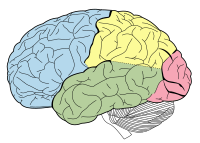
The localization and lateralization of fear aura and its surgical prognostic value in patients with focal epilepsy
Sign Up to like & getrecommendations! Published in 2022 at "Annals of Clinical and Translational Neurology"
DOI: 10.1002/acn3.51607
Abstract: Fear aura has traditionally been considered relevant to epileptic discharges from mesial temporal areas, and few studies have investigated its effect on surgical outcome in drug‐resistant epilepsy. We aim to assess the localizing and lateralizing… read more here.
Keywords: localization lateralization; fear aura; fear; value ... See more keywords

Context fear learning and renewal of extinguished fear are dissociated in juvenile female rats.
Sign Up to like & getrecommendations! Published in 2019 at "Developmental psychobiology"
DOI: 10.1002/dev.21888
Abstract: Extinction is the decrease in emotion to a cue that was previously associated with an emotionally significant event. It involves repeated presentation of the cue without any consequences. In adult animals, extinguished fear to a… read more here.
Keywords: fear; renewal; cue; context fear ... See more keywords

Parenting under pressure: Parental transmission and buffering of child fear during the COVID-19 pandemic.
Sign Up to like & getrecommendations! Published in 2022 at "Developmental psychobiology"
DOI: 10.1002/dev.22253
Abstract: The current study investigated the impacts of parental behaviors (threat communication and comforting) on children's COVID-19 fears and whether effects differed by age. Caregivers of 283 children (5.5-17 years, M = 10.17, SD = 3.25) from 186 families completed… read more here.
Keywords: threat information; threat; fear; covid threat ... See more keywords

Quantifying fear effects on prey demography in nature.
Sign Up to like & getrecommendations! Published in 2018 at "Ecology"
DOI: 10.1002/ecy.2381
Abstract: In recent years, it has been argued that the effect of predator fear exacts a greater demographic toll on prey populations than the direct killing of prey. However, efforts to quantify the effects of fear… read more here.
Keywords: fear effects; fear; predator cues; effect ... See more keywords

Extinction and discrimination in a Bayesian model of context fear conditioning (BaconX)
Sign Up to like & getrecommendations! Published in 2021 at "Hippocampus"
DOI: 10.1002/hipo.23298
Abstract: The extinction of contextual fear is commonly an essential requirement for successful exposure therapy for fear disorders. However, experimental work on extinction of contextual fear is limited, and there little or no directly relevant theoretical… read more here.
Keywords: fear; fear conditioning; extinction; context fear ... See more keywords

Effect of intra‐BLA overexpression of IGF‐1 on the expression of a contextual fear memory trace
Sign Up to like & getrecommendations! Published in 2022 at "Hippocampus"
DOI: 10.1002/hipo.23465
Abstract: Growth factors, such as insulin‐like growth factor 1 (IGF‐1), among others are known for their critical involvement in learning and memory processes. IGF‐1 regulates cognitive functions, synapse density, neurotransmission, and adult neurogenesis and induces structural… read more here.
Keywords: overexpression; bla; trace; fear ... See more keywords

The subfornical organ regulates acidosis‐evoked fear by engaging microglial acid‐sensor TDAG8 and forebrain neurocircuits in male mice
Sign Up to like & getrecommendations! Published in 2022 at "Journal of Neuroscience Research"
DOI: 10.1002/jnr.25059
Abstract: An important role of pH homeostasis has been suggested in the physiology of panic disorder, with acidosis as an interoceptive trigger leading to fear and panic. Identification of novel mechanisms that can translate acidosis into… read more here.
Keywords: acidosis; acid; physiology; fear ... See more keywords

Design and validation of a new instrument to assess fear of falling in Parkinson's disease
Sign Up to like & getrecommendations! Published in 2019 at "Movement Disorders"
DOI: 10.1002/mds.27820
Abstract: Fear of falling may be significantly associated with falls in Parkinson's disease (PD) and may have a negative impact on quality of life. Nevertheless, there are no valid and reliable tools to examine this condition… read more here.
Keywords: fear; assess fear; parkinson disease; instrument assess ... See more keywords

Dopamine D1-like receptors in the dorsomedial prefrontal cortex regulate contextual fear conditioning
Sign Up to like & getrecommendations! Published in 2018 at "Psychopharmacology"
DOI: 10.1007/s00213-018-5162-7
Abstract: RationaleDopamine D1 receptor (D1R) signalling is involved in contextual fear conditioning. The D1R antagonist SCH23390 impairs the acquisition of contextual fear when administered systemically or infused locally into the dorsal hippocampus or basolateral amygdala.ObjectivesWe determined… read more here.
Keywords: fear; fear conditioning; sch23390; dorsomedial prefrontal ... See more keywords

Coulrophobia: how irrational is fear of clowns?
Sign Up to like & getrecommendations! Published in 2017 at "European Journal of Pediatrics"
DOI: 10.1007/s00431-017-2896-x
Abstract: Dear Editor: In a large study, Meiri et al. found that 1.2% of hospitalised children experience a fear of clowns (coulrophobia) [2]. Their findings are very interesting, particularly in light of our recent study, which… read more here.
Keywords: irrational fear; clowns coulrophobia; fear; coulrophobia irrational ... See more keywords

Oxytocin facilitates adaptive fear and attenuates anxiety responses in animal models and human studies—potential interaction with the corticotropin-releasing factor (CRF) system in the bed nucleus of the stria terminalis (BNST)
Sign Up to like & getrecommendations! Published in 2018 at "Cell and Tissue Research"
DOI: 10.1007/s00441-018-2889-8
Abstract: Despite its relatively well-understood role as a reproductive and pro-social peptide, oxytocin (OT) tells a more convoluted story in terms of its modulation of fear and anxiety. This nuanced story has been obscured by a… read more here.
Keywords: fear; anxiety; human studies; models human ... See more keywords